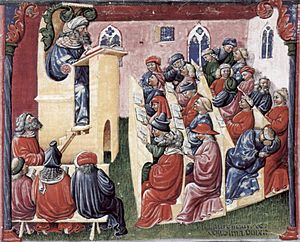Scholasticism facts for kids
Scholasticism was a special way of thinking and teaching that became popular in the Middle Ages. Imagine trying to mix old ideas from Ancient Greece (called classical philosophy) with the religious teachings of Christianity. That's what Scholasticism was all about! It wasn't just a type of philosophy or religion itself, but more like a method for learning and teaching. A big part of it was using something called dialectic. This means asking questions and discussing different ideas to find the best answer or solve a problem.
Contents
What is Scholasticism?
Scholasticism was a method used mainly in universities during the Middle Ages. It focused on using logic and reason to understand and explain difficult ideas. People wanted to connect the wisdom of ancient thinkers, especially from Greece, with Christian beliefs.
How Scholasticism Worked
Teachers and students would carefully read important texts. Then, they would discuss different viewpoints. They looked for arguments for and against an idea. The goal was to find the truth and make sure it fit with Christian teachings. This method helped people think deeply and clearly about complex topics.
Who Started Scholasticism?
Some of the earliest thinkers who helped start Scholasticism were Saint Ambrose and St. Augustine. They were important Christian leaders.
Early Christian Thinkers
Ambrose and Augustine tried to use ideas from philosophy to help explain the rules and mysteries of the Christian church. They were among the first to bring together Christian ideas and ancient Greek philosophy. They showed how reason could support faith.
Key Thinkers of Scholasticism
Many important thinkers contributed to Scholasticism. They shaped how people learned and thought for centuries.
Famous Scholastic Philosophers
Some of the most famous figures in Scholasticism include Peter Abelard, Albertus Magnus, Duns Scotus, William of Ockham, and Bonaventure. But the most important one was Thomas Aquinas.
Thomas Aquinas and His Work
Thomas Aquinas wrote a very important book called Summa Theologica. This book was a huge effort to combine Greek philosophy with Christian teachings. It tried to explain everything from God to human nature using both faith and reason.
How Scholastics Learned
In the 13th century, the ideas of Aristotle became very important. People thought his writings were more useful than those of Plato.
Learning from Ancient Texts
Scholastic education relied heavily on written texts. Students would study these texts and discuss arguments for and against the ideas within them. This was different from modern science, which uses observations from nature.
Languages and Books
Scholastics mainly worked with old books written in two ancient languages. One was Latin, which was the language of the Vulgate Bible. The other was Ancient Greek. Knowing Greek allowed them to read the original writings of Greek philosophers.
Faith and Reason
A famous saying by Boethius was: "As far as you are able, join faith to reason." This reminds us that all scholastics were Christians from the Middle Ages. Their main goal was to see how ancient Greek ideas could fit into their religious view of the world. They believed that faith and reason could work together.
See also
 In Spanish: Escolástica para niños
In Spanish: Escolástica para niños


